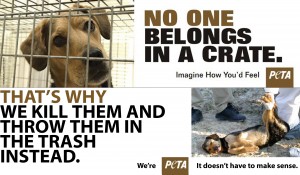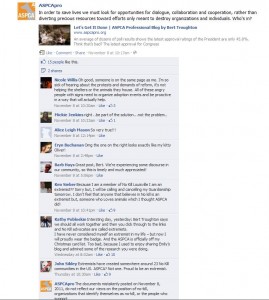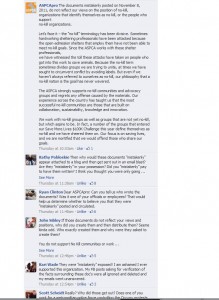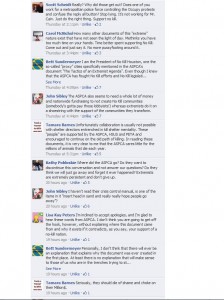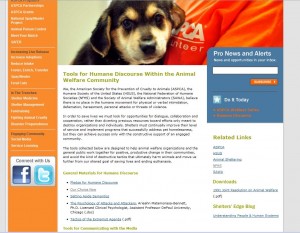“The most potent and cost-effective outreach vehicle is the development of a creative volunteer program. Were shelters to place a high priority on this area through attracting, training, and skillfully utilizing a volunteer outreach corps, they could begin the transition from killing site to a community resource center. A true shelter should be a place where life is affirmed, both in teaching and practice, not a building permeated with the odor of death” ~Ed Duvin, “In the name of mercy,” 1989

Lexie was killed in Columbus, GA this week despite being friendly and having an adoption committment.
PETA has some advice for communities looking to end the population-control killing of homeless pets: keep right on killing.
My head hurts. My heart hurts. I am not surprised.
Some weeks have a theme. This week’s theme has been cognitive dissonance, that feeling you get when presented with inconceivably mind-bending scenarios. It can lead to a search for answers, a further exploration and questioning of oneself and the world, to a desire to reshape the world and oneself, or it can lead to a distortion of thought, forcing it to fit where it does not. What you choose to do with it makes all the difference in the world.
To become a No Kill advocate is to step through the looking glass of animal welfare, into a world where what is is so often the opposite of what is logical, just, and common sense. Every day is filled with cognitive dissonance. Killing is kindness. Nobody wants to kill, yet shelters kill 3-4 million pets every year—half of all they take in. Shelters kill animals with rescue on the way. People calling themselves animal lovers make excuses for these things. Killing healthy and treatable and friendly pets is “euthanasia.” We call the places that do the killing “shelters.” Pets are labeled “unwanted,” blaming them for their own killing. And so on, and so on.
And the organization billing itself as the “largest animal rights organization in the world,” the one known for extremism in advocating against the wearing of fur, the eating of meat, and the testing of cosmetics on animals, the one known for its founder’s statement that “animals are not ours to eat, wear or experiment on,” the one for which no ad campaign in the name of veganism is too tasteless, makes excuses for the killing of homeless pets, advocates the killing of homeless pets, and kills thousands of homeless pets every year.
How do “animal rights” and “needless killing” manage to peacefully coexist within the same organization and within the individuals that comprise it? The right to live is fundamental to all others. Without that, there are no other rights. How are they unable to see the hypocrisy of this, even when it is pointed out to them repeatedly, even when the evidence piles as high as the stack of dead bodies in that infamous walk-in freezer? How do they recognize the role cognitive dissonance plays in how other people justify what they do to animals, choosing to keep the same old beliefs when confronted with conflicting information, yet can’t see it in themselves?
Up is down and black is white.
The excuses are a slow-moving target, but a moving target nonetheless. There’s the irresponsible public, which has enjoyed perhaps the longest popularity–over 35 years; pet overpopulation, another classic; and, more recently the notion that animal rescue is often a front for hoarding and dog fighting has been on the ascent, perhaps as the previous two are losing some of their old appeal. These excuses all have a few things in common—they are false—myths created from gross exaggerations and deliberate misrepresentations, but with small grains of truth that have given them traction. A minority of pet owners are irresponsible, that is true, and those who work in shelters or rescue will see a disproportionate number of this minority, but that is not why shelters kill. There are a lot of homeless animals, but that is not the same thing as ‘overpopulation.’ Hoarding and dog fighting exist, but to say that they are epidemic in animal rescue is nothing but a lie concocted to serve a nefarious purpose.
Hoarding is a mental illness, and hoarding of animals is a relatively rare mental illness. Mental health experts have yet to reach a consensus as to its underlying cause. Animal hoarding cases receive an increasing amount of media attention because they are so freakish and unusual. A search of the Pet-Abuse website, a site that tracks all manner of cases of pet abuse, for hoarding cases* with the keyword ‘Georgia’ yielded 12 cases in the entire state in over 10 years. Of those, two involved rescue—one was a volunteer (but not a foster care volunteer) at a rescue, the other, was the Loonie Farms case.
The state of Georgia, unlike many, requires that animal shelters and rescues be licensed and inspected by the Department of Agriculture. There are currently over 400 nonprofit rescue groups licensed in Georgia. Suffice to say, that rescue hoarding is very, very rare.
Shelter killing is commonplace. A report prepared by the Georgia Voters for Animal Welfare estimates that Georgia’s taxpayer-funded animal control shelters kill 62% of the animals they take in–260,000 dogs and cats every year, so in the past 10 years, Georgia shelters killed upwards of 2.6 million animals. (The overall trend nationwide is that killing is declining, so would likely have been even higher in the years prior to the GVAW report.) Many thousands of animals die in Georgia shelters for every one that may end up in these bad rescue situations.
And how many dogfighters would want to get a rescue license from the Department of Agriculture and deal with paperwork and inspections so that they could pull animals from shelters when they could steal them or get them from ‘free-to-good homes’ ads? Clearly these risks are grossly overstated.
Which brings me to a letter sent from PETA to Mayor Teresa Tomlinson of Columbus, GA. You can read it by clicking here. Apparently the No kill advocacy going on in Columbus caught PETA’s attention and they wanted to offer the beleaguered mayor some advice that only an organization that kills nearly every animal they get their hands on can. They hope their letter finds her well. They always hope their letters find the recipient well. It’s like they don’t have the social skills or brainpower to come up with a different opening line.
Things have been heating up in Columbus in recent months as a growing number of its citizens become aware of the mismanagement and rampant killing there, and of the fact that there is a better way. This past week a dog named Lexie was killed despite having an adoption commitment. Further background on the Columbus situation is available here, here, and here. The local TV station aired this piece recently, and the public response to it led to another one airing February 22 in which the Mayor cited this letter from PETA as support for her claim that not killing would be harmful to animals.
And this during not just any week, but the very week that PETA’s own kill stats for 2011 were released. PETA kills the animals it seeks out and takes in to its Bates Motel for pets so-called shelter (they alternately refer to it as a ‘shelter’ or an ‘office building,’ depending on the situation) at a rate of 97%–far worse than all but a handful of Georgia animal controls. This is despite, or perhaps because of its budget of over $30 million. Bill yourself as a champion of rights, build a relentless publicity machine, and you too can get away with murder.
In 2011, PETA took in 2029 animals (mostly dogs and cats, and some “other” animals such as rabbits) “for purpose of adoption.” They killed 1965 of them. Only 28 were adopted and 11 reclaimed. PETA transferred 34 to kill shelters, where they may or may not have been adopted and other animals may or may not have been killed to make room for them. PETA’s adoption rate in 2011 was 1.4%. One-point-four percent. 97% went on to occupy the walk-in freezer in PETA’s headquarters. Keep in mind that over 90% of pets entering shelters are healthy or treatable, and there is no evidence that the pets taken in and killed by PETA are any different. PETA has been consistently unable to produce evidence otherwise, even when pointedly asked.
PETA would prefer that the status quo continue. Though they apparently aren’t aware that rescues are licensed and inspected in GA, they disparage concerned citizens, animal rescuers and No Kill advocates (some of whom are or have been shelter directors themselves) as “individuals and groups unfamiliar with the inner workings of animal care and control facilities (or the daily challenges and heartbreaks that shelter workers face).” Really? What is it about these “inner workings” that cannot be understood by ordinary people not inducted into the mysteries? They don’t explain that but present a collection of straw men, falsehoods and a couple of articles, one of them poorly written fear mongering about hoarding, the other one they apparently didn’t read very carefully. It concludes with the story of how Best Friends, perhaps the best-known no-kill animal sanctuary in the country, and host of the annual No More Homeless Pets Conference, orchestrated rescue and adoption for the hundreds of feline victims of the FLOCK hoarding case in Pahrump, NV.
They cite cases where No Kill has not succeeded, but fail to mention that none of those were following the No Kill Equation, the only proven method for ending population control killing in open-admission shelters. They ignore the growing list of communities where No Kill is succeeding—28 as of this writing. They ignore that we have known that it can be done for almost 11 years.
The letter is signed by Jennifer Brown, who notes that she can be reached at (630)966-8895 or JenniferB@peta.org.
On one side we have the product of the nation’s oldest animal welfare organization, the ASPCA’s Tactics of the Extremist Agenda, and on the other the product of an organization over 100 years younger, one that prides itself on being seen as extremist in the name of animal rights, yet which kills and rehashes excuses for killing that mostly date from before it was founded. PETA has nothing of substance to offer. It is weak, derivative and backward, trading off the false image it has crafted.
Why would anyone want to take advice (and say so on TV!) on animal sheltering from an organization, which, despite a budget of over $30 million, has an even worse kill rate than all but a very few in Georgia? Why align oneself with an organization that is unpopular with those who don’t care about animals and is doubly so with informed people who care about homeless pets? Why do so while claiming to be “the most progressive”? That is not a winning situation no matter how you look at it.

PETA uses lies to try to prevent a bill that would clarify that TNR, the most humane and effective way of managing feral cat populations, is not prohibited in Virginia.
Ed Duvin, who sparked the No Kill movement with his 1989 essay “In the Name of Mercy,” could have been rebutting PETA’s campaign against the No Kill movement in general, and against Virginia’s S.B 359 in particular when he wrote “Speciesism: Alive and Well”. Heck, I hope this finds them well:
“Instead of recognizing our movement’s historical and contemporary role in this holocaust, many leaders continue to rationalize it on the basis of a “humane” death being preferable to a “miserable” life – further arguing that we are best able to provide this “merciful” end. Desperate humans are grievously suffering by the tens of millions all over the world, but who can imagine relief agencies endorsing systematic euthanasia as an acceptable policy. A vastly different ethic applies for companion animals, however, and most of our movement remains silent.”
And:
“Deciding that death for other beings is preferable to a risk-filled life is not euthanasia in its traditional form, but rather a lethal manifestation of speciesism that projects our own fears and values onto another species, and then proclaims – as though we were omniscient gods – that death is our loving “gift” to them.”
And:
“A recent issue of the leading shelter publication spared no effort in denigrating progressive programs to support feral cats. The thrust of this dogmatic criticism was that euthanasia is preferable to neuter-and release programs, claiming such programs expose ferals to the risk of “terrifying lives and tragic deaths.” Here again, we see the “kill, kill, kill” mentality – arrogantly presuming that certain death is a kinder fate for ferals than uncertain life. How ironic, as Thoreau pointed out, that the most desperate lives are lived quietly by humans, and yet no one is euthanizing us for our own protection!”
And:
“During the past few years, I have witnessed more anger from the Shelter Establishment directed at critics than the grotesque slaughter, and this sorrowful lack of priority and proportion is indicative of a malignancy in the soul of our movement.”
The thing is, he wrote that back in 1990. It’s 2012 and they still don’t get it.
If you are from Virginia, please join Alley Cat Allies, No Kill advocates, and some of the best-performing shelters in the country in voicing your support for S.B. 359, which clarifies that TNR is not prohibited in Virginia by clicking here.



